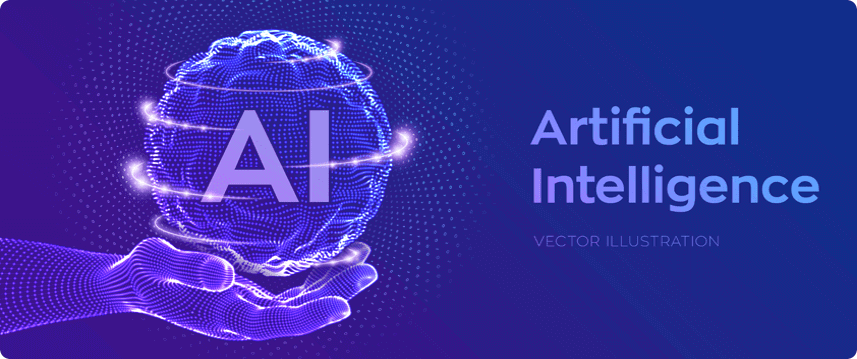
It's no secret that data is becoming a more valuable business asset, with the amount of data produced and stored on a worldwide scale expanding at an exponential rate. Of course, collecting data is meaningless if nothing is done with it, yet these massive swaths of data are just unmanageable without the assistance of automated systems.
Artificial intelligence, machine learning, and deep learning enable businesses to gain value from the massive amounts of data they collect by providing business insights, automating processes, and improving system capabilities. AI/ML has the ability to revolutionize every part of a company by assisting them in achieving measurable objectives such as :
- Increasing customer satisfaction
- Offering differentiated digital services
- Optimizing existing business services
- Automating business operations
- Increasing revenue
- Reducing costs
What are the Components of AI?
-
Learning :Computer programs, like humans, learn in a variety of ways. When it comes to AI, this platform's learning is divided into a variety of categories. Learning for AI comprises the trial-and-error approach, which is one of the most important aspects of AI. The solution continues to solve problems until it obtains the desired results. As a consequence, the programs keeps track of all the movements that resulted in positive outcomes and stores them in its database for use the next time the computer is presented with the same problem.
-
Reasoning :Reasoning is one of the most important components of artificial intelligence because of its ability to differentiate. To reason is to allow the platform to make inferences that are appropriate for the situation at hand.
-
Problem-solving :In its most basic form, AI's problem-solving ability consists of data, with the answer requiring the discovery of x. The AI platform sees a wide range of problems being handled. The various 'Problem-solving' approaches are artificial intelligence components that split questions into special and general categories.
-
Perception :When the 'perception' component of Artificial Intelligence is used, it scans any given environment utilising various artificial or actual sense organs. Furthermore, the processes are maintained internally, allowing the perceiver to examine other scenes in suggested objects and comprehend their relationships and characteristics. This analysis is frequently problematic as a result of the fact that similar products might have a wide range of looks depending on the viewpoint of the indicated angle.
-
Language-understanding :Language can be defined as a collection of diverse system indications that use convention to justify their means. Language understanding, which is one of the most extensively used artificial intelligence components, employs distinct types of language across various forms of natural meaning, as shown by overstatements.
What are the Components of MI?
-
Data Set :Machines require a large amount of data to function, learn from, and ultimately make judgments. Any unprocessed fact, value, sound, image, or text that may be evaluated and analysed can be considered data. A data set is a collection of similar-genre data collected across multiple environments.When building a data set, make sure that it has 5V characteristics :Volume : Data scalability is important. The larger the data collection, the better for the machine learning model. The model's ability to make the best selections is aided by the large data collection.Variety : Different types of data, such as photographs and videos, might be included in the data set. The importance of data variety in guaranteeing accuracy in results cannot be overstated.Velocity : The rate at which data is accumulated in the data set is important.Value : The data set should contain relevant information. It is vital to maintain a large data set with valuable information.Veracity : Data accuracy is critical while sustaining a data set. Data accuracy translates to precision in the output.
-
Algorithms :Consider an algorithm to be a mathematical or logical programs that converts a set of data into a model. Depending on the sort of problem the model is trying to answer, the resources available, and the nature of the data, many types of algorithms can be used.Machine learning algorithms employ computer approaches to "learn" information directly from data rather than depending on a model based on a preconceived equation.
-
Models :A model is a computational representation of real-world processes in machine learning. An ML model is trained to recognize specific patterns by running it through a series of algorithms on a set of data. A model can be used to make predictions once it has been trained.
-
Feature Extraction :Datasets can have a variety of characteristics. If the characteristics in the dataset are similar or fluctuate widely, the observations stored in the dataset are likely to cause overfitting in an ML model.
-
Training :Training entails methods for ML models to recognize patterns and make judgments. This can be accomplished in a variety of ways, including supervised learning, unsupervised learning, and reinforcement learning.
What is Data Science?
Data science is an interdisciplinary field that use scientific methods, procedures, algorithms, and systems to extract knowledge and insights from noisy, structured, and unstructured data, as well as to apply that knowledge and actionable insights to a variety of application areas.
Data science remains one of the most promising and in-demand career pathways for qualified individuals. Today's effective data professionals recognise that they must go beyond the traditional abilities of large-scale data analysis, data mining, and programming. Data scientists must master the complete spectrum of the data science life cycle and possess a level of flexibility and awareness to maximize returns at each stage of the process in order to unearth meaningful intelligence for their organizations.
The Data Science Lifecycle
-
Capture :Data Acquisition, Data Entry, Signal Reception, and Data Extraction are the first steps in the data capture process. This stage entails gathering unstructured and structured data in its raw form.
-
Maintain :Data Warehousing, Data Cleansing, Data Staging, Data Processing, and Data Architecture should all be maintained. This stage entails taking the raw data and converting it into a usable format.
-
Process :Data mining, clustering/classification, data modelling, and data summarization are the steps in the process. Data scientists assess the produced data for patterns, ranges, and biases to see if it will be useful in predictive analysis.
-
Analyze :exploratory/confirmatory, predictive/confirmatory, regression, text mining, and qualitative analysis This is when the lifespan gets interesting. This stage entails performing a variety of data analyses.
-
Communicate :Data Reporting, Data Visualization, Business Intelligence, Decision Making. In this final step, analysts prepare the analyses in easily readable forms such as charts, graphs, and reports.
What is ML?
Types of Machine Learning Algorithms
-
Supervised learning :
Algorithms :Instructs models to produce the desired output using a training set. This training dataset contains both correct and incorrect outputs. In simple terms, the algorithm tries to forecast the intended output based on historical data.Application :Regression, classification, decision trees, random forest, naive bayes, and SVM are some of the terms used in machine learning.It is utilized in the prediction of house prices for regression.
-
Unsupervised learning :
Application :Is a technique for training a model without using labels (output feature). Unsupervised learning, in other terms, allows the system to recognize patterns in data sets on its own.It is employed in the segmentation of customers.
-
Recommendation systems :
Applications :Is a type of information filtering system.Example :Netflix, Youtube, Tinder and Amazonwhen a user tries to buy a product like fridge through Amazon, then Amazon application will suggest(recommend) products associated with fridge like fridge cover, stand etc.
-
Semi-supervised learning :
Application :Is an approach to machine learning that combines a small amount of labeled data with a large amount of unlabeled data during training.It is being used in Speech Analysis.
-
Reinforced learning :
Application :Is a feedback-based Machine learning technique in which an agent learns to behave in an environment by performing the actions and seeing the results of actions. For each good action, the agent gets positive feedback, and for each bad action, the agent gets negative feedback or penalty.Trajectory optimization, motion planning, dynamic pathing, controller optimization. Tesla using Reinforcement Learning
What is Deep Learning?
Deep Learning structures algorithms in layers to create an “artificial neural network” that can learn and make intelligent decisions on its own. Deep learning uses a complex structure of algorithms modeled on the human brain. This enables the processing of unstructured data such as documents, images and text.
Deep learning is a subset of machine learning.
Types of Deep Learning Networks
What is NLP?
List of AI Tools & Frameworks
- Scikit Learn
- TensorFlow
- Theano
- Caffe
- MxNet
- Keras
- PyTorch
- CNTK
- Auto ML
- OpenNN
- H20 : Open Source AI Platform
- Google ML Kit
Cost of Investment to do AI/ML in your organization.
Trajectus can start AI/ML journey in your organization. We can do it together.
-
We can educate you and your teams :This step sounds trivial, but a general understanding is vital to successfully using this technology. We recommend taking a deep dive into topics like MLOps, Model Development Lifecycle, and the importance of relative data. Working in cross-functional teams is also a good way to get familiar with AI/ML basics.
-
We together can select a pilot project :Start small when selecting your pilot project. Avoid attempting to solve the most complex problem with AI/ML technology in your organization. Instead, find a small initiative that can make a measurable impact for a particular group or department in your organization.
-
We can get you expert advice :If your organization doesn’t have the capability in-house, get our expert advice. You may need experts who can assist you with collaboration across teams, define new processes, and gather technology advice.
-
We can help you prepare your data :Data is the most crucial part of your project. You will need lots of it. The more data, the better.
-
we can help you define the metrics for your model :This is one of the most crucial phases in which the subject matter experts (SME) define how to validate the AI/ML model’s success. There are many metrics available such as precision, recall and accuracy. Every use case is different and selecting the correct validation metric is vital for a successful outcome. A model built for medical diagnoses will have different considerations than building a model for spam detection.
-
Explore data with our SMEs and run experiments :Work with SMEs or domain experts to further understand what data is useful, and how to achieve optimal metrics defined earlier. Experiment with different algorithms and hyperparameters to find the best fit for your pilot’s use case.
-
Train and validate your model with us :For training and validating your Model, it is recommended to split your data into three sets : a training set (~ 70%), a test set (~15%) and a validation set (~ 15%). Ensure your training set is large enough to see meaningful results when using the model on it.
-
we can implement DevOps and MLOps :Building a model is a job half done, then integrating it into your end-to-end lifecycle might be challenging. Often when data scientists develop models on their laptops, integration into production becomes a significant challenge. The operations teams and development teams need to collaborate with data scientists in iterative ways. Automation is key, and continuous integration and continuous deployment (CI/CD) can help get the model operational, fast.
-
Move your model into production :Once the model has been built and thoroughly tested, it is ready for production rollout. If possible, roll out to a small number of users first. Monitor the model’s performance over several days. Be sure to include stakeholders and SMEs in these discussions to evaluate results and provide continuous feedback. Once the stakeholders have accepted the model’s performance, the model can then be rolled out to a broader audience.
-
Keep your model relevant to the real world :Once your model is in production, we can help you to continuously monitor and adjust the model’s performance based on its current market situation. Market conditions can be triggered through various events.
-
Celebrate success and promote the outcome :Once your pilot project is successful, promote and advertise it within your organization. Use internal newsletters, internal websites, or even consider an email from the pilot’s sponsor sent out to stakeholders to promote the successes.












